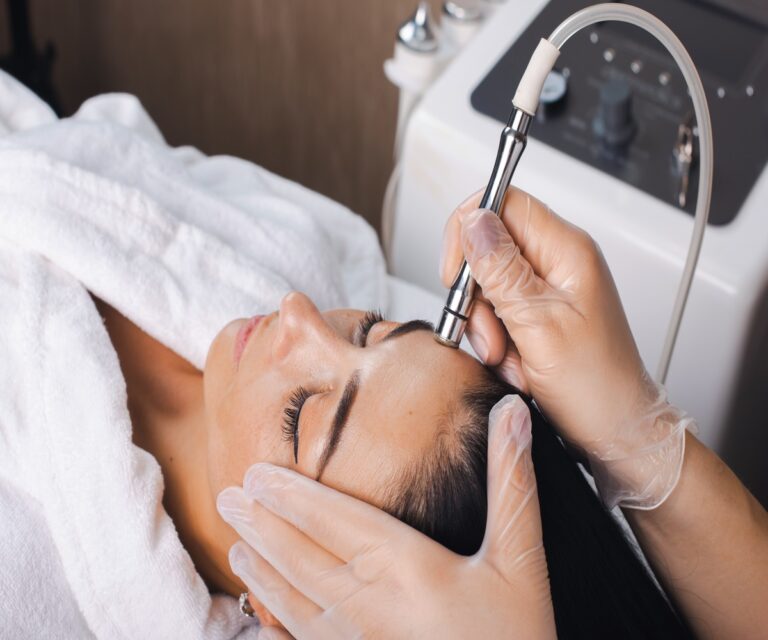A Comprehensive Guide to Microdermabrasion

The quest for a youthful, radiant complexion is a timeless pursuit. Sun damage, environmental factors, and the natural aging process can all contri wte to uneven skin tone, fine lines, and a dull appearance. Microdermabrasion emerges as a powerful weapon in the anti-aging arsenal, offering a minimally invasive and effective way to achieve smoother, brighter skin.
This comprehensive guide delves into the world of microdermabrasion, exploring its benefits, how it works, different techniques, aftercare tips, and who can benefit from this treatment.
Understanding Microdermabrasion
Microdermabrasion is a non-surgical cosmetic procedure that gently removes the outermost layer of dead skin cells. It utilizes a handheld device with a textured surface or a fine crystal spray to exfoliate the skin, revealing a smoother, more even-toned appearance.
Benefits of Microdermabrasion
Microdermabrasion offers a multitude of benefits for achieving a more youthful and radiant complexion:
- Exfoliation and Improved Skin Texture: By removing dead skin cells, microdermabrasion promotes smoother, softer skin. This can also minimize the appearance of enlarged pores and rough patches.
- Reduced Appearance of Fine Lines and Wrinkles: Stimulating collagen production, the body’s natural scaffolding protein, microdermabrasion can help soften the appearance of fine lines and wrinkles, particularly those on the sun-exposed areas of the face.
- Diminished Sun Damage: Microdermabrasion can be effective in addressing uneven skin tone caused by sun damage, such as age spots and hyperpigmentation.
- Improved Product Penetration: By removing the dead skin cell layer, microdermabrasion allows skincare products to penetrate deeper, enhancing their effectiveness.
- Brighter and More Even Skin Tone: By eliminating the dull outer layer, microdermabrasion reveals a brighter, more radiant complexion.
Types of Microdermabrasion Techniques
There are two primary techniques used in microdermabrasion:
- Crystal Microdermabrasion: This traditional method utilizes a handheld device with a diamond-tipped or crystal-tipped attachment to exfoliate the skin. The crystals create a slight abrasive effect, removing dead skin cells as they are vacuumed away.
- Diamond Microdermabrasion: This newer technique uses a diamond-tipped wand to gently abrade the skin’s surface. It is often considered to be more comfortable and offer more precise control compared to crystal microdermabrasion.
What to Expect During a Microdermabrasion Treatment
A microdermabrasion treatment typically follows these steps:
- Consultation: A consultation with a dermatologist or aesthetician is crucial to discuss your goals, medical history, and suitability for the treatment.
- Cleansing: The skin is thoroughly cleansed to remove any makeup, oil, or dirt.
- The Microdermabrasion Procedure: The chosen microdermabrasion device is used to gently exfoliate the skin in a controlled manner. The aesthetician will adjust the intensity based on your skin’s sensitivity and desired results.
- Moisturizing: A moisturizer and sunscreen are applied to soothe and protect the treated skin.
Microdermabrasion Aftercare Tips
Following a microdermabrasion treatment, proper aftercare is essential to optimize results and minimize potential side effects:
- Gentle Skincare: Use gentle, fragrance-free cleansers and moisturizers for a few days after treatment.
- Sun Protection: Religiously apply sunscreen with SPF 30 or higher daily, as the newly revealed skin is more susceptible to sun damage.
- Minimize Makeup: Avoid wearing heavy makeup for at least 24 hours after treatment.
- Avoid Harsh Products: Skip harsh scrubs, astringents, and exfoliating products for a week following treatment.
Who Can Benefit from Microdermabrasion?
Microdermabrasion is a versatile treatment suitable for various skin concerns. It can be particularly beneficial for individuals with:
- Fine lines and wrinkles.
- Uneven skin tone and sun damage.
- Enlarged pores.
- Dull and rough skin texture.
- Acne scars (mild to shallow).
Considering Microdermabrasion? Here's What to Ask
If you’re considering microdermabrasion, here are some crucial questions to ask your dermatologist or aesthetician:
- Am I a good candidate for microdermabrasion?
- What type of microdermabrasion technique do you recommend for my skin type and concerns?
- How many sessions will I need to achieve my desired results?
- What is the expected downtime after treatment?
- What are the potential side effects of microdermabrasion?
Summary
In conclusion, microdermabrasion stands out as a highly effective treatment for those seeking to rejuvenate their skin and address a range of complexion issues. By understanding its benefits, techniques, and proper aftercare, you can make informed decisions to achieve a brighter, smoother, and more youthful appearance. Whether combating fine lines, sun damage, or uneven skin tone, microdermabrasion offers a valuable solution in your skincare journey.
